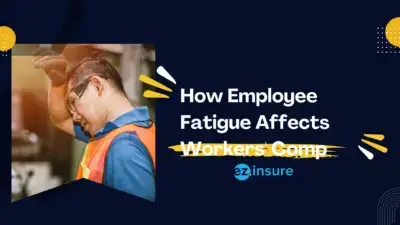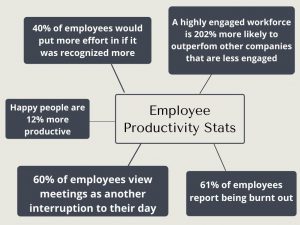 Employee fatigue has become a major worry for both workers and employers in today’s fast-paced and demanding work environments. Employee hours are increasing longer as our economy demands more and more from its workers. This frequently implies that employees can work much beyond the regular work week, putting them at risk of tiredness and fatigue. It is true that when we are weary, we are more prone to mishaps. We are less aware of our surroundings and cannot respond as swiftly to avoid injury. They can also have a significant impact on a company’s financial health.
Employee fatigue has become a major worry for both workers and employers in today’s fast-paced and demanding work environments. Employee hours are increasing longer as our economy demands more and more from its workers. This frequently implies that employees can work much beyond the regular work week, putting them at risk of tiredness and fatigue. It is true that when we are weary, we are more prone to mishaps. We are less aware of our surroundings and cannot respond as swiftly to avoid injury. They can also have a significant impact on a company’s financial health.
Worker Fatigue
Fatigue is more than just feeling tired. Fatigue is a state of exhaustion that has persisted for an extended amount of time. It can have a significant impact on many aspects of an employee’s life. People are not designed to work for hours on end with no breaks. Our bodies require at least 7 hours of rest and recharge per day. Here are some examples of fatigue symptoms:
- When employees are tired, their reaction time can slow down a lot. This could be dangerous or even deadly at some jobs.
- Making decisions slowly or not at all. When employees are too tired to remember what to do, they often make bad choices. This effect on tired workers is very important because in some places of work, a bad choice can put a lot of people in danger.
- Lack of attention span. It is harder for employees to focus on certain jobs when they are tired. If they can’t think straight, they might forget to do their work, which could lead to a dangerous situation.
- Dozing off at work due to lack of sleep or rest.
- When employees are tired, they might have any of these symptoms: aches and pains in their muscles, a change in their appetite, gastrointestinal issues, sleepiness, anxiety, headaches, or emotional distress.
Imagine that you have to do the same job every day, week after week, with nearly no breaks. Over time, this can and will lead to accidents. When our brains are tired, we have a higher tendency to mess up when we’re figuring things out. For businesses in fields where measures are important, this could be a major problem. Being tired, we might not pay as much attention to our surroundings. If you work with tools or operate heavy machinery, this is especially dangerous.
Impact Of Fatigued Employees
The costs associated with overworked employees go beyond the immediate issue of decreased production; they permeate many other parts of business operations, which has an effect on the bottom line. Employers have a responsibility to acknowledge the significance of treating fatigue in the workplace, putting into action initiatives that encourage employee well-being, and ultimately cultivating a work environment that is both healthier and more productive. Employers have the ability to lessen the financial burden of weariness and contribute to the long-term success of their businesses if they make investments in the health and satisfaction of their workforce.
Decreased Productivity
One of the most direct consequences of employee fatigue is a decline in productivity. Over-tired workers are likely to experience reduced focus, slower reaction times, and impaired decision-making abilities. This drop in productivity can lead to lower output, increased errors, and a general decline in the quality of work, all of which contribute to financial losses for employers.
Increased Absenteeism
Fatigue often leads to increased absenteeism as employees may find it challenging to meet their work commitments. Regular absences can disrupt workflow, result in missed deadlines, and require additional resources to cover the workload gaps. This not only affects immediate productivity, but can also result in additional costs associated with temporary staffing or overtime payments to cover absent employees.
Higher Accident Rates
Fatigue is a known contributor to workplace accidents. Over-tired workers are more prone to making mistakes, and their diminished alertness increases the risk of injuries and accidents. Workplace incidents not only incur direct costs such as medical expenses and potential legal liabilities, but can also lead to increased insurance premiums for employers.
Increased Healthcare Costs
Fatigue is associated with various health issues, both physical and mental. Over time, exhausted employees may experience a decline in overall health, leading to increased healthcare utilization and associated costs for employers. This includes expenses related to medical treatments, doctor visits, and potential long-term disability claims.
Employee Turnover
A workforce experiencing chronic fatigue is more likely to suffer from burnout and dissatisfaction. This dissatisfaction can contribute to higher employee turnover rates as workers seek environments that prioritize their well-being. The costs associated with recruiting, training, and onboarding new employees can be substantial for employers.
Lower Innovation and Creativity
Fatigue not only affects routine tasks, but also hampers creativity and innovation. Over-tired employees may struggle to think critically, solve problems, or contribute fresh ideas. This can hinder a company’s ability to adapt to changing market dynamics and innovate, potentially resulting in missed opportunities and revenue growth.
How You Can Prevent Employee Fatigue
It can be dangerous for employees to work when they are tired. According to research, being tired is just as bad for the brain as driving while drunk. Memory, balance, focus, decision-making, and movement skills are all affected by fatigue in workers. It also leads to about 13% of accidents and injuries at work every year. It’s true that you can’t suddenly make sure your employees get enough rest to do their job safely and well, but these tips can help companies make jobs safer by keeping workers from getting too tired at work.
Educate Your Employees
In some of the most significant incidents that have ever occurred in the workplace, fatigue has been identified as a contributing cause. It is important to provide training to all employees, particularly supervisors, in order to identify signs of exhaustion in workers. When employees are aware of the indicators, they are able to take greater precautions to ensure that they get sufficient sleep at night. For those in charge, bringing it to the attention of workers and encouraging them to take breaks is helpful.
Think About How You Schedule Shifts
Employees who work shifts that are late at night or overnight are more prone to experience high levels of fatigue. When scheduling staff, try to avoid arranging them for shifts that are irregular or rotating. Additionally, fatigue tends to develop tremendously during a shift that lasts for twelve hours. Employees should be given at least a 24-hour rest in between 12-hour shifts, and overtime should be prohibited for those working those schedules.
Enforce Breaks
In order for workers to recover from repetitive tasks, it is the responsibility of employers to guarantee that they receive their permitted breaks. It is possible to restore essential functions to the brain and boost focus with as little as fifteen minutes of break time.
Avoid Extended Shifts When Possible
According to the recommendations of the Occupational Safety and Health Administration (OSHA), companies should make every effort to prevent their employees from working more than forty hours per week or working odd shifts whenever it is feasible to do so. Some examples of uncommon shifts include working two shifts in the same day, such as working four hours in the morning and then returning for a three-hour shift in the evening. Another example is working two shifts in a single day. It may also involve shifts that are not consistent with one another, such as working an evening shift, then a morning shift, and then continuing on to work overnight shifts. Please do not hesitate to get in touch with OSHA directly if you consider your schedules could potentially compromise your safety in accordance with this recommendation.
Paid Sick Leave
If you’re a business owner, paid sick leave might seem like an extra cost to think about, but new paid sick leave isn’t just a perk for workers. It’s also good for business. Employees who can take paid sick leave are less likely to miss work, which is good for business. Being sick at work makes you much less effective, and there’s a chance that you could spread the infection to other people. Putting your whole staff at risk to meet business goals is a very unprofessional thing to do. It can also cost a lot more in the long run than just giving employees a few sick days a year.
One thing we can say for sure is that using employee scheduling tools to track and manage your staff is a must if you want to make your business run more smoothly. Without a doubt, it can be very helpful for people who have problems with their workers being too busy or people who don’t want it to happen in the first place.
Finding Business Insurance With EZ
We are able to assist you in obtaining commercial insurance to safeguard your company as well as group health insurance for your employees. To ensure that you are able to get the most suitable insurance coverage for your company and its employees, our representatives collaborate with the most reputable insurance providers around the country. In fact, we are able to save you hundreds of dollars annually. We do this by working with your budget to locate the most suitable coverage for you or your family. If you have any inquiries, please do not hesitate to contact us at the following numbers: 877-670-3531 for assistance with group health insurance, and 877-670-3538 for assistance with commercial insurance. You can also simply enter your zip code into the bar below for free instant quotes.



